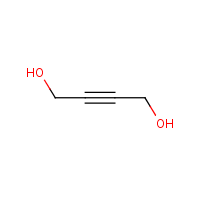Butynediol
Agent Name
Butynediol
CAS Number
110-65-6
Formula
C4-H6-O2
Major Category
Other Classes

Synonyms
1,4-Butinodiol [Spanish]; 1,4-Butynediol (VAN); 1,4-Dihydroxy-2-butyne; 2-Butin-1,4-diol [Czech]; 2-Butin-1,4-diol [Czechoslovakia]; 2-Butynediol; Agrisynth B3D; Bis(hydroxymethyl)acetylene; But-2-yne-1,4-diol; Butynediol-1,4 [French]; 2-Butyne-1,4-diol; [ChemIDplus] UN2716
Category
Other Organic Compounds
Description
White to yellow solid; [HSDB] Yellow or amber colored chips or chunks; [MSDSonline]
Sources/Uses
Used to produce flame retardants and other chemicals; Also used as a corrosion inhibitor, pickling agent, paint remover, cleansing agent, descaling agent, electroplating brightener, defoliant, polymerization accelerator, and stabilizer for chlorinated hydrocarbons; [HSDB]
Comments
A severe skin and eye irritant; [HSDB] Toxic by inhalation, ingestion, and skin contact; [CAMEO] May cause skin burns and sensitization; [eChemPortal: ESIS] A corrosive substance that can cause injury to the skin, eyes, and respiratory tract; Inhalation may cause chemical pneumonitis; May cause skin sensitization; Causes liver, brain, and reproductive injury in high-dose animal studies; [MSDSonline] Danger of cutaneous absorption; Danger of skin sensitization; [MAK]
Biomedical References
Exposure Assessment
MAK
0.1 ppm
Vapor Pressure
0.000556 mm Hg
Lethal Concentration
LCLo (rat) = 150 mg/m3/2h
Explanatory Notes
Flash Point = 128 deg C; [HSDB]
Adverse Effects
Skin Sensitizer
Yes
Toxic Pneumonitis
Yes
Neurotoxin
Other CNS neurotoxin
Hepatotoxin
Hepatoxic (a) from occupational exposure (secondary effect) or (b) in animal studies or in humans after ingestion
Reproductive Toxin
Yes
Dermatotoxin
Skin burns
Diseases, Processes, and Activities Linked to This Agent
Diseases
Occupational diseases associated with exposure to this agent:
Processes
Industrial Processes with risk of exposure: